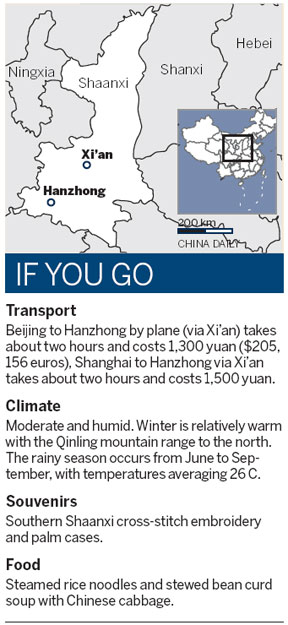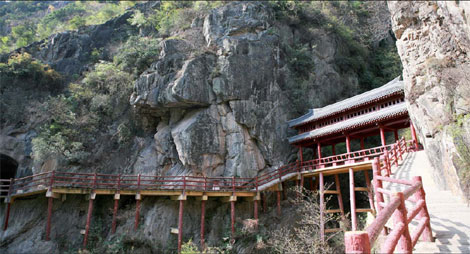Highway to history
Updated: 2012-03-23 07:48
(China Daily)
|
||||||||
|
|
Shaanxi gems put travelers on a time journey
Mention Shaanxi province and many travelers will immediately think of its terracotta warriors or historic capital Xi'an. But in the province's southwest, lies Hanzhong, a lesser-known city that is steeped in Chinese history and culture. It also boasts one of the rarest natural habitats for that Chinese darling of the world, the wild giant panda.
Hanzhong lies south of the Qinling mountain range, which makes up China's major geographical north-south divide, to the north of the Daba Mountain and with Hanzhong Basin in the center. It is at the upper reaches of the Han River, one of the many tributaries of the Yangtze River. The water of China's South-to-North Water Diversion Project that aims to help ease North China's water shortage comes mainly from this area.
Hanzhong draws its name from the Yangtze and about 2,400 years ago, the Qin Kingdom during the Warring States Period (475-221 BC) established settlements in Hanzhong. It is also the birthplace of the Han Dynasty (206 BC-AD 220), from which the majority Han ethnic group gets its name.
Here are some of Hanzhong's main attractions.
1. Ancient Plank Road
 |
So as early as the Warring States Period, Chinese engineers were building plank roads along the cliffs and slopes of Qinling. They carved out holes in stone and embedded wooden beams to support the planks. Wooden railings were also erected to protect travelers from plunging to their deaths.
The backbreaking work gradually developed into an intricate network of roads to become one of the country's oldest "highways".
Ninety-percent of the historic plank roads are in Hanzhong's mountainous region, among which Baoxie Plank Road, more than 200 kilometers long, is the most famous. The original section of plank road was destroyed and only the holes used for putting the beams left in the mountainsides remain. On the cliffs along the remains of the plank road, visitors can make out many engravings by ancient poets and scholars. Many other parts of the roads were burnt during wars and most of them have decayed in the past 2,000 years, but travelers can still experience the history written in them. In 1996 the local government restored 600 meters on the old site modeled after the ancient building style and created new tourist spots such as the Fengyu and Cuiyun pavilions and Mountain Gate, for tourists to retrace the historical footprints.
2. Foping National Nature Reserve
Foping is located in the south of Foping county. Many rare and endangered species of plants can be found here. At Luban Peak, travelers are shrouded in clouds and can see glacial remains close up.
But the nature reserve is most famous for being one of the rarest habitats for the wild giant panda.
There are about 200 giant pandas in the nature reserve, much less than the population of their southern cousins in Sichuan. The Foping pandas are also known to be extremely delicate and sensitive, making winter the best time to observe them - from December to April. When the forest is covered with snow, the giant pandas move to the lower altitudes to forage for bamboo.
At other times, the pandas either live in the higher mountain regions or in the core zone areas from which tourists are barred to help minimize human impact on the area.
3. South Lake
The 70-hectare lake, located 17 km southwest of Hanzhong, offers a backdrop of verdant mountains framing clear waters. The surrounding area takes on the characteristics of China's typical southern landscapes in an area of the Loess Plateau more known for scarce vegetation and sandstorms. South Lake is also home to a many types of flowers and plants and is dubbed the first lake of Shaanxi - a miniature of the green treasures of the Hangzhong landscape.
There are also exquisite Chinese traditional gardens amid the lake's natural forests. A museum in memory of Lu You, the Song Dynasty (960-1279) poet whose patriotic poems still strike a chord with many modern Chinese, is found here.
4. The Tomb of Cai Lun
The tomb, located at Longting village, 10 km east of Yangxian county, is the manor and burial place of the papermaking inventor Cai Lun. The 52-square-kilometer site also boasts traditional Chinese building relics ancient gardens. There are rare ancient trees, such as a 1,000-year-old cypress and cassia bark, that can be traced back to the Han Dynasty. Surrounded by ancient cypresses and bamboo forests, the temple offers a serene site for people to pay tribute to the great inventor.

 Relief reaches isolated village
Relief reaches isolated village
 Rainfall poses new threats to quake-hit region
Rainfall poses new threats to quake-hit region
 Funerals begin for Boston bombing victims
Funerals begin for Boston bombing victims
 Quake takeaway from China's Air Force
Quake takeaway from China's Air Force
 Obama celebrates young inventors at science fair
Obama celebrates young inventors at science fair
 Earth Day marked around the world
Earth Day marked around the world
 Volunteer team helping students find sense of normalcy
Volunteer team helping students find sense of normalcy
 Ethnic groups quick to join rescue efforts
Ethnic groups quick to join rescue efforts
Most Viewed
Editor's Picks

|

|

|

|

|

|
Today's Top News
Chinese fleet drives out Japan's boats from Diaoyu
Health new priority for quake zone
Inspired by Guan, more Chinese pick up golf
Russia criticizes US reports on human rights
China, ROK criticize visits to shrine
Sino-US shared interests emphasized
China 'aims to share its dream with world'
Chinese president appoints 5 new ambassadors
US Weekly

|

|








